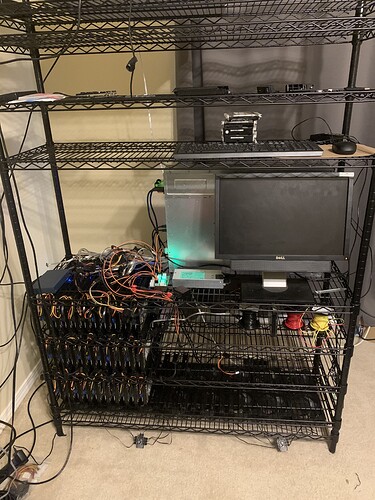Hey all, here’s an update to my post back in May about my DIY farming rig. Here’s an updated pic!
It has grown from 22 drives back then to over 60 drives today with about 20 more to install and space for over 250! I’ve created custom 3d printed rails and sliders for the hard drives so they are easy to slide in and out. Currently I’ve got 60 drives loaded in bottom 3 shelves. Here’s a closeup so you can see the drives have 2 rows per shelf (front and back):
I’ve also upgraded to Wal-Mart’s finest 5-shelf wire rack, although I had to buy 2 of them to get the amount of shelves I needed.
The entire bottom shelf is filled with 16 140mm case fans pushing cool air from the ground up into the drives. I’m still working on wiring them all up, but for now I have a box fan (not pictured) blowing air into them from the side to keep them cool.
All of the drives are powered from the 1200 watt server power supply you see on the shelf next to the monitor. I’m pretty sure that 60 drives is the limit, as I’ve watched it’s main voltage output drop from 12.2v to 12v. I’ve got 2 more of these on the way and I’ll probably just power 50 drives on each to be safe.
The big metal box you see behind the monitor is a Dell PowerEdge r520 with dual 8-core Xeon chips and 32gb ram. I got 2 of these for a great deal at a public auction and they are perfect for this. It has 4 16x PCI-e slots. I currently have 2 6 port SATA cards plugged in. Each of these ports is connected to a 1-to-5 port multiplier that hangs behind the disks on each shelf for a total of 60 SATA drives. I’ve got 2 more PCI-e slots, so I can get 60 more drives in this server. But I also just received this new 12 port card and expect to test it soon. That would get me to a theoretical limit of 240 drives controlled by a single server!
I have a few more mounts I need to design and 3d print, but once I’m finished with that I plan on making the 3d printed files available for sale as well as the full design docs and parts lists as a digital download. Would you be interested in such a product and if so, how much would you expect to pay for it? Any other feedback, ideas, suggestions, criticisms, safety warnings?





